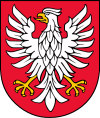Siedlce
| Siedlce | |||
|---|---|---|---|
|
|
|||
|
|||
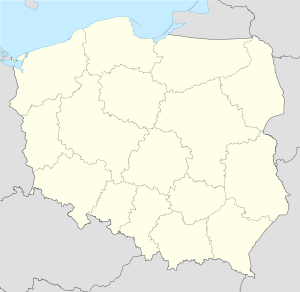 Siedlce
|
|||
| Coordinates: | |||
| Country | |||
| Voivodeship | Masovian | ||
| County | City county | ||
| Established | 1448 | ||
| Town rights | 1547 | ||
| Government | |||
| - Mayor | Wojciech Kudelski | ||
| Area | |||
| - Total | 32 km2 (12.4 sq mi) | ||
| Elevation | 155 m (509 ft) | ||
| Population (2006) | |||
| - Total | 77,047 | ||
| - Density | 2,407.7/km2 (6,236/sq mi) | ||
| Time zone | CET (UTC+1) | ||
| - Summer (DST) | CEST (UTC+2) | ||
| Postal code | 08-100 to 08-119 | ||
| Area code(s) | +48 025 | ||
| Car plates | WS | ||
| Website | http://www.siedlce.pl/ | ||
Siedlce [ˈɕɛdlt͡sɛ] (![]() listen) (Yiddish: שעדליץ Shedlits, Russian: Седльце Sedlets (Latinized)) is a town in eastern Poland with 77,092 inhabitants (as of 2005[update]). Situated in the Masovian Voivodeship (since 1999), previously the town was the capital of a separate Siedlce Voivodeship (1975–1998).
listen) (Yiddish: שעדליץ Shedlits, Russian: Седльце Sedlets (Latinized)) is a town in eastern Poland with 77,092 inhabitants (as of 2005[update]). Situated in the Masovian Voivodeship (since 1999), previously the town was the capital of a separate Siedlce Voivodeship (1975–1998).
Towns such as Siedlce in the depressed east have now been emptied by large-scale emigration to the West. Statistics show that 14 per cent of employers recently reported labour shortages, compared with 8 per cent in the first quarter of 2004.
The town, which is part of the historical province of Lesser Poland, was most probably founded some time before 15th century and was first mentioned under the name of Siedlecz in a document of 1448. In 1503 Daniel Siedlecki erected a new village of the same name nearby and a church in the middle. In 1547 the town, created out of a merger of the two villages, was granted Magdeburg rights by King Sigismund the Old. Until 1807, when it was confiscated by the Russian authorities, it remained a private property of several notable magnate families, among them Czartoryski and Ogiński.
During the World War II more than 50% of all buildings in the city, including a historical town hall, were destroyed. The Jewish population perished in the Holocaust.
Contents |
Jewish History
Up to the Second World War, like many other cities in Europe, Siedlce had a significant Jewish population. At some times, indeed, Jews were the majority of its population.
The presence of Jews at Siedlce is attested from the middle 16th Century - inn keepers, merchants and artisans. A Jewish hospital existed in the town since the early 18 Century.
In 1794 a Beit Midrash (study hall) was founded in the town and 1798 the Jewish cemetery was extended, testifying to the increase of the community. These changes conincided with the town coming under Austrian rule with the Third Partition of Poland. Until 1819 the Jewish community of Warsaw, 90 kilometres to the west, was formally subject to the authority of the Siedlce rabbis.
For much of the 19th Century - a time when the town's population steadiuly increased - Jews were the majority of Siedlce's population: 3,727 (71.5%) in 1839; 4,359 (65%) in 1841; 5,153 (67.5%) in 1858; 8,156 (64%) in 1878. Later on, the percentage of Jews decreased due to non-Jewish migration: according to Russian census of 1897, out of the total population of 23,700, Jews constituted 11,400 (so around 48% percent).[1]. In 1890 the old Jewish hospital was repalced by a newer and much bigger one.
In the late 19th and early 20th Century, secular political and cultural activity was evident among Jews in Siedlce, as in the whole of Eastern Europe. In 1900 the Bund started activity in the town, as did the Zionist movement, and many of the town's Jews were adherents of Polish Socialist Party. Between 1911-1939 two Yiddish weeklies were published in the town, and a Jewish highschool was founded during the First World War.
The antisemitic persecutions perptrated by the Black Hundreds in the last decades of Tasrist rule toched Siedlce with a pogrom in 1906, in which 26 Jews perished. In the wake of the First World War the town was affected by the Polish-Soviet War, being occupied by the Red Army in 1920 and by the Polish Army in 1921 - the latter being accompanied by fresh antisemitic manifestations.
The first Polish census, in 1921, recorded 14,685 Jews living in Siedlce, constituting 48% pf the population as in 1897. Their number remained steady in the interwar period, and in 1939, on the eve of the Second World War, there were some 15,000 Jews living in the town. Their fate, like that of Polish Jewry in general, was sealed by Nazi Germany occupying Poland.
In 1940 the Nazis exiled to Siedlce some thousand Jews from elsewhere in Poland - especially Lodz, Kalush and Pabianice. In March 1941 - still before the formal decision to implement the "Final Solution" of wholesale extermination the Jews - Nazi forces rampaged for three days in Siedlce, killing many of its Jewish inhabitants. In August of the same year the town's Jews were herded into a ghetto and on October 1, 1941 were completely cut off from the outside world.
In August 1942 some 10,000 of the Siedlce Jews were deported to Treblinka and murdered there. The town's remaining Jews were sent off to extermination on November 25, 1942.
The Siedlce Jewish community was not restored after Nazi defeat, and the town's later history lacked the hitherto conspicuous Jewish component. Survivors of the town's population established an association in Israel which in 1956 published a comprehnsive memorial book on the community's history.[2]. Y. Kravitz, one of the survivors, published in 1971 his memoires entitled "Five Years of Living Hell under Nazi Rule in the City of Siedlce" [3].
Education
Higher education
- Akademia Podlaska (University of Podlasie)
- Wyższa Szkoła Finansów i Zarządzania (The College of Finance and Management)
- Wyższe Seminarium Duchowne (Theological seminary)
- Instytut Teologiczny (Institute of Theology)
- Nauczycielskie Kolegium Języków Obcych (Foreign Languages Teachers' College) granting diplomas of the University of Warsaw
- Medical University of Warsaw, Faculty of Health Sciences
- University of Bialystok, Faculty of Law
Notable secondary schools
- I LO im. Bolesława Prusa (Bolesław Prus Grammar School)
- II LO im. Św. Królowej Jadwigi (St. Queen Jadwiga Grammar School)
- Zespół Szkół Ponadgimnazjalnych nr 1 im. Stanisława Staszica (Stanisław Staszic Grammar School)
People from Siedlce
- Artur Boruc - a goalkeeper for Scotish Football Giants Celtic FC
- Richard Burgin - a Jewish composer who attended St. Petersburg Conservatory and became the concert master for the Boston Symphony Orchestra.
- Lidia Chojecka - a Polish middle distance runner who specializes in the 1500 metres and sometimes 3000 metres.
- Agata Wróbel - weightlifter, 2000 Summer Olympics silver medalist
- Aleksandra Klejnowska - weightlifter
- Bolesław Prus - writer, novelist
- Leon Wyczółkowski - painter
- Bohdan Arct - fighter pilot, writer
- Vladimir Chelomei - Soviet Academician and scientist in the field of mechanics and control processes; Designer of missiles, spacecraft, and space stations; Founder and the General Constructor of OKB-52 (now NPO Mashinostroyenia).
Media in Siedlce
Operate in this area a local television (TV Siedlce) and the Catholic radio station Radio Podlasie. Here are the location of the regional headquarters: TVP Warsaw/TVP Info, RDC (Radio For You) and Radio Eska. Also you can hear:
- Polish Radio Program I (Jedynka) - nationwide program, News/Features
- Polish Radio Program II (Dwojka) - Classical / Culture
- Polish Radio Program III (Trojka) - nationwide program, Pop/Rock
- Polish Radio, Program IV, (Euro) - Youth/lifestyle programs
- Radio dla Ciebie (RDC) - (Editors in Siedlce) - Regional service
- RMF FM - nationwide program, Adult Contemporary
- Radio ZET - nationwide program, Hot Adult Contemporary
- Radio Eska - (Editors in Siedlce) - Pop/Dance/Local service
- Eska Rock - Rock station
- Radio Maryja - nationwide program, religious station
International relations
Twin towns — Sister cities
Siedlce is twinned with:
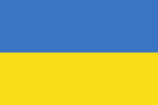 Berdychiv, Ukraine
Berdychiv, Ukraine Dasing, Germany
Dasing, Germany Kirov, Russia
Kirov, Russia Pescantina, Italy
Pescantina, Italy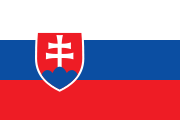 Sabinov, Slovakia
Sabinov, Slovakia Vawkavysk, Belarus
Vawkavysk, Belarus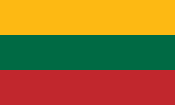 Vilnius Region, Lithuania
Vilnius Region, Lithuania
Gallery
|
City hall |
The District Court |
The Post Office |
|
City hall |
St. Stanislas Church |
Kiliński Street |
See also
- Siedlce Department (Polish: Departament Siedlecki): a unit of administrative division and local government in Polish Duchy of Warsaw in years 1806–1815.
- Gdańsk-Siedlce - one of the quarters of the city of Gdańsk.
Notes
- ↑ Joshua D. Zimmerman, Poles, Jews, and the politics of nationality, Univ of Wisconsin Press, 2004, ISBN 0299194647, Google Print, p.16
- ↑ Wolf Yesni (ed.) "Memorial to the Siedlce Communiry - 14 Years Since its Destruction" (in Yididsh), 1956
- ↑ ,י.קראוויץ, "החיים בגיהנום, חמש שנים תחת שלטון הנאצים בעיר שדליץ", תשל"א
External links
- Official Siedlce website (English)
|
||||||||||
|
||||||||||||||

